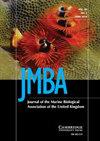Evidence of distribution overlap between Atlantic and Baltic grey seals
IF 0.9
4区 生物学
Q3 MARINE & FRESHWATER BIOLOGY
Journal of the Marine Biological Association of the United Kingdom
Pub Date : 2024-03-15
DOI:10.1017/s0025315424000213
引用次数: 0
Abstract
Grey seals from both the Atlantic and Baltic Sea subspecies are recovering from dramatic declines and recolonising former ranges, potentially leading to overlapping distributions and an emerging subspecies transition zone in Kattegat between Denmark and Sweden. The two subspecies have asynchronous moulting and pupping seasons. We present aerial survey data from 2011 to 2023 in Danish Kattegat during the Atlantic subspecies' moulting (March–April) and pupping (December–January) seasons, as well as the Baltic subspecies' moulting season (May–June). During the Atlantic subspecies' peak moulting season, 82% of the grey seals were recorded north of the island of Læsø (N57°18′, E11°00′). In contrast, during the Baltic moulting season in those years, only 9% of the grey seals were recorded here. This indicates a predominance of Atlantic grey seals in the north and Baltic grey seals in central and southern Kattegat. In 2022 and 2023, three pups were recorded around Læsø during early January, which coincides with the pupping season of northern Wadden Sea grey seals. Previously, pups have been recorded in the same locations during the Baltic pupping season, which demonstrates overlapping breeding ranges. Grey seals are known to have plasticity in the timing of pupping indicated by a west to east cline of progressively later pupping in the eastern North Atlantic. Historical sources document that the Baltic pupping season in Kattegat was earlier than it has been in recent years. Thus, the expanding ranges may be associated with convergence of Atlantic and Baltic subspecies' pupping seasons and potential hybridisation in this emerging transition zone.大西洋灰海豹和波罗的海灰海豹分布重叠的证据
大西洋和波罗的海两个亚种的灰海豹正在从急剧下降中恢复过来,并重新占领以前的分布区,这有可能导致分布区重叠,并在丹麦和瑞典之间的卡特加特出现一个亚种过渡区。这两个亚种的换羽和产仔季节不同步。我们提供了 2011 年至 2023 年大西洋亚种换羽期(3 月至 4 月)和产仔期(12 月至 1 月)以及波罗的海亚种换羽期(5 月至 6 月)在丹麦卡特加特海峡的航测数据。在大西洋亚种的换羽高峰期,82%的灰海豹都在莱索岛(N57°18′,E11°00′)以北被记录到。相反,在这些年的波罗的海换羽季节,只有 9% 的灰海豹在这里被记录到。这表明北部主要是大西洋灰海豹,而卡特加特海峡中部和南部主要是波罗的海灰海豹。2022 年和 2023 年 1 月初,在莱索附近记录到三只幼海豹,这恰好是北部瓦登海灰海豹的产仔季节。此前,在波罗的海灰海豹产仔季节,也曾在相同地点记录到幼崽,这表明灰海豹的繁殖范围存在重叠。众所周知,灰海豹的产仔时间具有可塑性,北大西洋东部灰海豹的产仔时间由西向东逐渐推迟。据历史资料记载,卡特加特海峡的波罗的海产仔季节早于近几年。因此,范围的扩大可能与大西洋和波罗的海亚种的产仔季节趋同以及这一新兴过渡区的潜在杂交有关。
本文章由计算机程序翻译,如有差异,请以英文原文为准。
求助全文
约1分钟内获得全文
求助全文
来源期刊
CiteScore
2.30
自引率
8.30%
发文量
68
审稿时长
3-8 weeks
期刊介绍:
JMBA is an international journal, publishing original research on all aspects of marine biology. It includes pioneering work taking place today on major issues concerning marine organisms and their environment. Subjects covered include: ecological surveys and population studies of marine communities; physiology and experimental biology; taxonomy, morphology and life history of marine animals and plants; and chemical and physical oceanographic work. Included with 2010 online subscriptions: Marine Biodiversity Records.

 求助内容:
求助内容: 应助结果提醒方式:
应助结果提醒方式:


